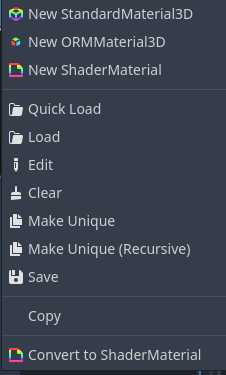xyz Ah, well that explains that.
I took a look at the Schlick-GGX implementation found here (starting at line 1147), and porting it resulted in something that much more resembles the default material (though it's not completely identical yet).
For anyone else who's interested, here's my current (very quick & messy) port job.
`float D_GGX(float cos_theta_m, float alpha)
{
float alpha2 = alpha * alpha;
float d = 1.0 + (alpha2 - 1.0) * cos_theta_m * cos_theta_m;
return alpha2 / (PI * d * d);
}
float G_GGX_2cos(float cos_theta_m, float alpha)
{
float k = 0.5 * alpha;
return 0.5 / (cos_theta_m * (1.0 - k) + k);
}
vec3 F0(float metallic, float specular, vec3 albedo)
{
float dielectric = 0.16 * specular * specular;
return mix(vec3(dielectric), albedo, vec3(metallic));
}
float SchlickFresnel(float u)
{
float m = 1.0 - u;
float m2 = m * m;
return m2 * m2 * m;
}
void light()
{
vec3 lightColor = LIGHT_COLOR / PI;
// Diffuse light.
float NdotL = max(dot(NORMAL, LIGHT), 0.0);
DIFFUSE_LIGHT += clamp(dot(NORMAL, LIGHT), 0.0, 1.0) * ATTENUATION * lightColor;
// Specular light.
vec3 halfway = normalize(VIEW + LIGHT);
float NdotH = max(dot(NORMAL, halfway), 0.0);
float LdotH = max(dot(LIGHT, halfway), 0.0);
float NdotV = max(dot(NORMAL, VIEW), 0.0);
float alpha_ggx = ROUGHNESS * ROUGHNESS;
float D = D_GGX(NdotH, alpha_ggx);
float G = G_GGX_2cos(NdotL, alpha_ggx) * G_GGX_2cos(NdotV, alpha_ggx);
vec3 f0 = F0(METALLIC, SPECULAR_AMOUNT, ALBEDO);
float cLdotH5 = SchlickFresnel(LdotH);
vec3 F = mix(vec3(cLdotH5), vec3(1.0), f0);
vec3 specular_brdf_NL = NdotL * D * F * G;
float specular_blob_intensity = 0.25;
SPECULAR_LIGHT += specular_brdf_NL * LIGHT_COLOR * specular_blob_intensity * ATTENUATION;
}`
Thanks for the help!


